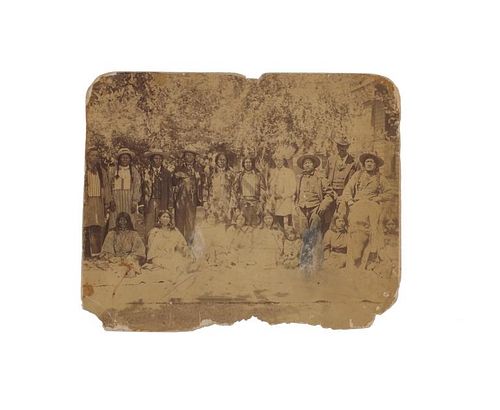This is a fantastic photograph circa 1896 by Horace S. Poley showing a large grouping of Southern Plains or Plains Native American Indians including an Indian Police member. Horace Swartley Poley was born in Norristown, Pennsylvania in 1864 and moved to Colorado in the 1880’s, being a resident of Colorado Springs for sixty-two years. Poley started a commercial photography studio in 1892 and remained active in photography until 1935. H.S. Poley was asked to photograph archaeological expeditions in New Mexico, Arizona, Utah, and southwest Colorado. In addition, Poley delivered lectures that featured his images in magic lantern shows, and was a member of the Colorado Springs Pioneer Society, the Knights of Pythias, and the National Archaeology Society. This image shows a total of nineteen Indians, possibly from the Ute tribe or Lakota Sioux tribe in a range of regalia including featured and beaded headdress, several hair-pipe bone breast plates, hair-pipe bone choke collars, beaded belts, what appears to be an Otter Mirror Sash which are documented as being from the Lakota Ihoka Badger Society amongst cowboy hats. The images show each male bearing a badge or metal as well as an Indian bearing an Indian Police badge. Truly a fantastic photograph with immense detail. The image is marked in the negative as shown in the bottom left corner which can be made out, “1896 H. S. Poley”. Horace S. Poley photographs are highly collectible with a grouping of smaller examples selling for $5,676.25 (shown w/ bp) at Heritage Auctions in 2011. Provenance: From the Jim Aplan Piedmont, South Dakota collection. Measures8 7/8” by 7.25”. The card shows some loss to the outside edge, particularly the bottom as well as some cracking, some markings in the field, speck dots or pin dots on each person’s eyes. The back is handwriting in graphite pencil but what it says can not be deciphered.
In 1937, the Denver Public Library acquired the Horace Swartley Poley collection. According to Randel Metz, "Horace Swartley Poley created a major collection of photographic images of Native Americans in the southwestern United States. Born in Norristown, Pennsylvania in 1864, Poley moved to Colorado in the 1880s and was a resident of Colorado Springs for 62 years. Poley started a commercial photo studio in 1892 and remained an active photographer until 1935. In addition to his photographic work, Poley served as head of the U.S. Postal registry department in Colorado Springs. During summer vacations, Poley served as photographer with archaeological expeditions in Arizona, New Mexico, Utah, and southwest Colorado. He recorded landscapes, cityscapes, and events in the Pikes Peak region of Colorado. Poley was noted for his travelogue lectures employing his images in 'magic lantern' shows." (Randel Metz's article about acclaimed Western photographer Horace Poley - Denver Public Library blog, June 9, 2015)
The Iho’ka or Badger Society was one of the Aki’cita eligible societies. Aki’cita (or Akicita) has been often translated as “soldier” or “warrior” but its more accurate implied meaning is more appropriately as “guard” or “police”. These Aki’cita Societies would act as “guards” and watch over the tribe when the tribe moved from one place to another and keep watch for enemy activity when a camp was chosen. Aki’cita also acted as “civil police” to preserve order in the camp and had the right to punish offenders of tribal codes or conduct. Warriors chosen to serve as Aki’cita also had the responsibility to maintain strict control during a Buffalo hunt. The Iho’ka (Ihoka) Badger Society were considered amongst the most extreme warriors of the Aki’cita. They were said to have been started by a man who dreamed of a badger. They often took great risks against seemingly insurmountable odds, emulating the great tenacity found in the behavior of a badger, who would not think twice about going nose to nose with a bear ten times its own size and winning the fight. Among the notable insignia of this society are the society’s crooked lances wrapped in wolf skin, quirts with one serrated edge and otter fur wrist loops along with otter skin yokes which were later adorned with trade mirrors to blind their enemies.












